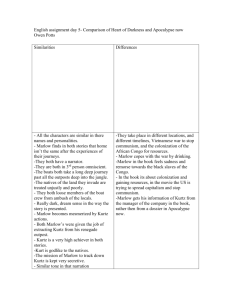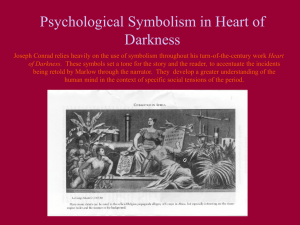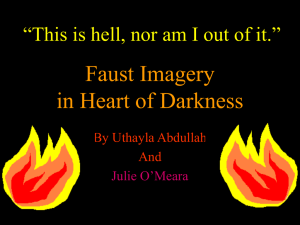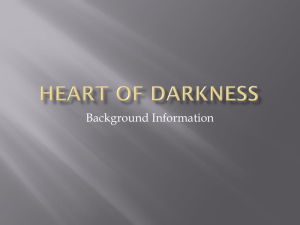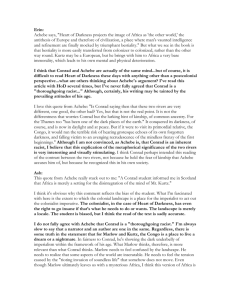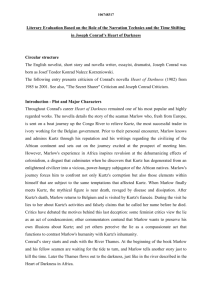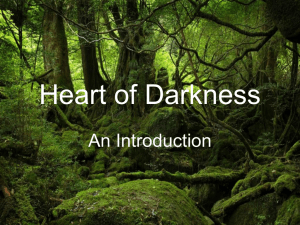HOD packet
advertisement
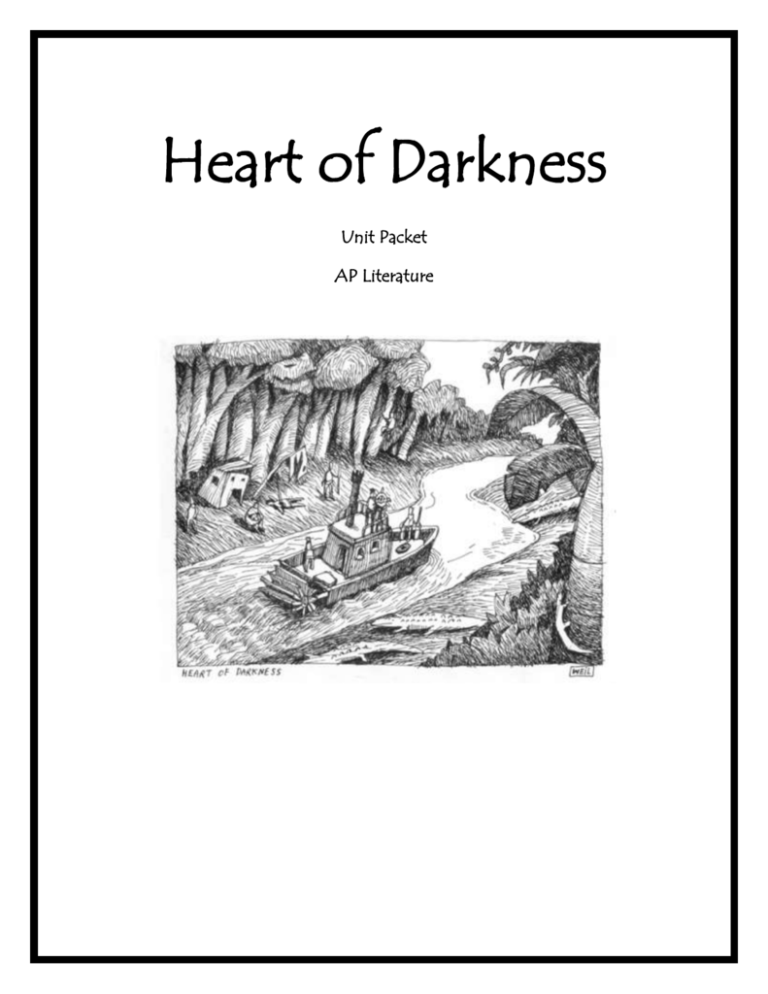
Heart of Darkness Unit Packet AP Literature Table of Contents: I. Reading Schedule and due dates II. Author Biography: Joseph Conrad III. Map of Africa for reference IV. Reading Strategies for H.O.D. V. Group Reading Questions to ponder and discuss as we travel the Congo VI. Close Reading Questions requiring a response I. Reading Schedule and due dates Tuesday 3/13: Lab 510: Work on Exercise 12 (Allusions) identify and define. Due Friday. Homework: View PowerPoint presentation “Africa: The Dark Continent” by Friday’s class (3/16). Read/annotate article “Genocide and Crimes Against Humanity: King Leopold II and the Congo” for class tomorrow Wednesday 3/14: Journal: Write a ½-1 page reflection on “Genocide…” article and connections. Turn in. Class discussion article “Genocide and Crimes Against Humanity: King Leopold II and the Congo” Anticipation Intro Guide--due Friday Assign texts, unit packet and reading discussion groups-- read Part I, p. 65-102 TWICE with notes due: Tuesday, March 20th Storytime! Read: Curious George Homework: View PowerPoint presentation “Africa: The Dark Continent” by Friday’s class (3/16). Read/annotate “Africa and Africans in Conrad’s Heart of Darkness” a Freshman Studies lecture by Dr. Candice Bradley, Professor of Anthropology, Lawrence University: due Friday 3/16. Thursday 3/15: Journal: Tarzan and Curious George reflection Read author’s biography (Part II) and Reading Strategies for H.O.D. (Part IV this packet) Lab open (510) if you need to finish Allusions or watch powerpoint on Africa. Finish reading Bradley Lecture for tomorrow. Homework: View PowerPoint presentation “Africa: The Dark Continent” by Friday’s class (3/16). Read/annotate “Africa and Africans in Conrad’s Heart of Darkness” a Freshman Studies lecture by Dr. Candice Bradley, Professor of Anthropology, Lawrence University: due Friday 3/16. Friday 3/16: Journal: “take-aways” from lecture and Africa Powerpoint Review Dr. Bradley’s in class—anthropology discussion; colonization of Africa Meet in your discussion groups in class—10 minutes. Discuss how you will divide and share the work on Google Docs. Reading time in class (not library)—Heart of Darkness, Part I Monday 3/19: Literary Analysis Exercise 13 Library: Work in your discussion groups on Part One, Close Reading Questions Part I questions 1-16. Due Tuesday 3/20: Library all hour: Work in your discussion groups on Part One, Close Reading Questions Part I—due Thursday, 3/22 Wednesday 3/21 Micayla French—Africa Start reading Part Two with notes (read it twice!): p. 102-133 by Friday Style: Figurative Language and Poetic Devices (Exercises 9 and 10) Thursday 3/22 Journal: Continue reading Part Two with notes (read it twice!): p. 102-133 by Friday Friday 3/23 Library all hour: Work in your discussion groups on Part Two and the Close Reading questions. Questions due Tuesday (3/27) Homework: Read Part Three p. 133-164 with notes (read it twice!) Monday 3/26 Library all hour: Work in your discussion groups on Part Two and the Close Reading questions. Questions due Tuesday. Tuesday 3/27 Literary Analysis—Selected Passage 2 (Exercise 14) Wednesday 3/28: Library --Work in your discussion groups on Part Two and the Close Reading questions (#18-43) for Part 2. Thursday 3/29: No school Friday—Enjoy your Spring Break!!! Monday 4/9 Begin reading questions part 3, p. 133-164. There will be a final test on Wednesday and a written test on Thursday, over the novella. Read through “Imperialism” handout. Read and mark up (form and meaning) Rudyard Kipling’s poem “The White Man’s Burden” and the four poems in response to it. Be ready to discuss tomorrow in class. poems/burden Discuss “Imperialism” handout, “The White Man’s Burden” and the four poems in response to it. II. Author Biography: Joseph Conrad Joseph Conrad (1857-1924), Polish-born English author and master mariner wrote Heart of Darkness (1902); . . . No, it is impossible; it is impossible to convey the life-sensation of any given epoch of one’s existence—that which makes its truth, its meaning—its subtle and penetrating essence. It is impossible. We live, as we dream—alone. . . .” (Part 1) With haunting verse Conrad has crafted a chilling tale laden with lush imagery and symbolism describing the ambiguity between good and evil. “He was obeyed, yet he inspired neither love nor fear, nor even respect. He inspired uneasiness. That was it!”—(ibid) With characters as antihero he examines man’s moral complexities and capacity for corruption and evil, and the dark depths of the human psyche; Anything approaching the change that came over his features I have never seen before, and hope never to see again. Oh, I wasn’t touched. I was fascinated. It was as though a veil had been rent. I saw on that ivory face the expression of sombre pride, of ruthless power, of craven terror—of an intense and hopeless despair. Did he live his life again in every detail of desire, temptation, and surrender during that supreme moment of complete knowledge? He cried in a whisper at some image, at some vision—he cried out twice, a cry that was no more than a breath. (ibid, Part 3) While it addresses the timeless struggle of man’s self-deception and inner conflicts, influenced by Conrad’s own sense of isolation from his past, the story of Marlow’s journey into the Congo also exposes the clashes, exploitation and barbarity between European and African societies during 19th Century colonial expansionism. Controversial in his time and even today, some of Conrad’s works including Heart of Darkness have inspired filmmakers and such authors as F. Scott Fitzgerald, Gabriel García Márquez, D.H. Lawrence, Joseph Heller, Albert Camus, and Virginia Woolf. He has also been grouped with other such esteemed authors as his friend Stephen Crane and Robert Louis Stevenson. As a young man Conrad, becoming disillusioned and having abandoned his native Poland after his parents sacrificed their lives in the fight for their country’s freedom, became a world traveler on the high seas. He gained by his own sweat and blood as a seaman the life experience and sensitivity for insight into the human condition needed to produce the dozens of famous short stories and novels he wrote, many that are still in print today. Józef Teodor Conrad Korzeniowski was born on 3 December 1857 in the Russian occupied city of Berdyczów, Ukraine. He was the only child born to Evelina Bobrowska (1832–1865) and Apollo Korzeniowski, (1820–1869) patriot, writer, and translator of such authors’ works as Victor Hugo’s and William Shakespeare’s. Joseph would also read their works as well as those of Charles Dickens, among many others’. As members of the Polish noble gentry szlachta living in the Ukraine under Tsarist autocracy was a turbulent time politically and the Korzeniowski’s were under constant surveillance. In 1861 Joseph’s nationalist father, who was an outspoken supporter of the serfs and critic of Poland’s oppressors, was arrested along with his wife for being involved with the Polish National Committee’s anti-Russian activities. They and four-year old Joseph were exiled to the province of Vologda in Northern Russia. The living conditions and harsh climate took their toll on Joseph’s parents: they both contracted tuberculosis, Evelina dying of it in 1865, Apollo in 1869. He was celebrated at his death by the Poles in patriotic honor. Shaken from their deaths and also suffering from various health problems that would plague him for the rest of his life, at the age of twelve Joseph became the ward of his maternal uncle Tadeusz Bobrowski (d.1894), a landowner who lived in Cracow, Poland. He would be a great support to Joseph morally and financially for many years to come. “He was then sixty-two years old and had been for a quarter of a century the wisest, the firmest, the most indulgent of guardians, extending over me a paternal care and affection, a moral support which I seemed to feel always near me in the most distant parts of the earth.” (A Personal Record, Ch. 2) As well as speaking Polish, Joseph had been taught French by his governess Mlle. Durand and received some schooling from his father. Now his uncle hired a student from Cracow University to continue his education, tutoring him in Latin, Greek, geography, and mathematics although Joseph disliked the formality of lessons. He was by nature full of nervous energy and physically active. His frustrated tutor soon learned that from an early age he yearned to travel on the seas and go to the ‘dark continent’ of Africa. In 1874 with his uncle’s blessing and as a way of avoiding conscription by the Russians, Conrad travelled to the bustling port town of Marseilles in southern France. As an important hub of the French Merchant Marine, Conrad was soon able to find employment with several French vessels over the next four years. It was the beginning of his fifteen year career as seaman during which he would meet so many of the men who would figure largely in his works. Life at sea was challenging but full of thrills and adventure and suited Conrad well who at times had a tempestuous personality. He visited many of the major ports of the world and worked on every kind of vessel possible including the ‘Sainte Antoine’, ‘Duke of Sutherland’ ‘Palestine’, ‘Otago’ and ‘Tremolino’. He was involved with gunrunning and smuggling for a time, and in the off hours incurred a number of gambling debts. When he could not repay them he attempted to commit suicide by shooting himself in the chest. He survived and his uncle paid off his debts but he lost his position with the French merchants so joined the English ship ‘Mavis’ in 1878. Two years later he passed his third mate’s exam and in 1886 earned his Master’s certificate in the British Merchant Service and became a British Citizen. It was at this time that he changed his name to Joseph Conrad. His next few years of service took him to various ports of call including the Malay Archipelago, the Gulf of Siam and the Belgian Congo. Under the employ of the Societe Anonyme pour le Commerce du Haut-Congo in 1890 Conrad at last plunged into the ‘dark continent’ and wrote his ‘Congo Diary’ that would later become The Heart of Darkness. The harsh conditions of travelling to the Congo Free State and working on a paddle-steamer aggravated Conrad’s already at-times fragile health. He suffered gout and had periods of depression for many years. He returned to England weakened and suffering from fever and was hospitalized. While his sense of humor and irony was intact, the Congo had also caused a profound effect on his emotional health ….it was infinitely more likely that the sanest of my friends should nurse the germ of incipient madness than that I should turn into a writer of tales—(A Personal Record, Ch. 5) However, in a spare hour here and there Conrad had been working on Almayer’s Folly (1895). And I, too, had a pen rolling about somewhere—the seldom-used, the reluctantly taken-up pen of a sailor ashore, the pen rugged with the dried ink of abandoned attempts, of answers delayed longer than decency permitted, of letters begun with infinite reluctance, and put off suddenly till next day—till next week, as like as not! (A Personal Record, Ch. 5) Little did Conrad know he was on his way to becoming one of the greatest 20th Century novelists, known for his mastery of atmosphere and dramatic realism, at times compared to Rudyard Kipling. Having now retired from the sea he settled in Kent County, England. Almayer’s Folly (1895) was published to mixed reviews though mostly positive. In March of 1896 he married Jessie Emmeline George (1873-1936) with whom he would have two sons, Borys (b.1898) and John (b.1906). Now that Conrad was retired and earnestly writing, he had numerous works first serialized in such publications as Blackwood’s, Munsey’s and Harper’s. Other works published around this time include An Outcast of the Islands (1896), The Nigger of the ‘Narcissus’ (1897), Tales of Unrest (1898), Lord Jim (1900), collaborations with Ford Madox Ford The Inheritors (1901) and Romance (1903), Youth (1902), The End of the Tether (1902), Typhoon (1903), Nostromo (1904), The Mirror of the Sea (1906, semi-autobiographical), The Secret Agent (1907), A Set of Six (1908), and Under Western Eyes (1911). Although he was now receiving a pension Conrad suffered financial difficulties for a number of years; it was with the immediate commercial success of Chance (1914) that was a turning point for him. Now living at his home ‘Oswalds’ in Bishopsbourne, Canterbury, he also travelled extensively including a trip to the United States in 1923 to give a reading where he was fêted by the press and hordes of admiring readers. In 1924 he was offered a Knighthood but politely declined. He had become friend to many public figures and fellow authors including John Galsworthy and H.G. Wells. While he maintained a busy schedule he also continued his prodigious output of writing until his death, further publications including; The Arrow of Gold (1914), Victory (1915), The Shadow-Line (1917) which evokes Samuel Taylor Coleridge’s “The Rime of the Ancient Mariner’, The Rescue (1920), and The Rover (1923). On 3 August 1924 Joseph Conrad died at home of a heart attack. Although a skeptic much of his life he was given a Roman Catholic service at St. Thomas’s and now rests with his wife Jessie in the Westgate Court Avenue public cemetery in Canterbury, England. His name is carved into the massive rough-hewn grave stone as was given at his birth, Joseph Teodor Conrad Korzeniowski. The epitaph is carved below; also the epigraph for The Rover is from Edmund Spenser’s The Faerie Queen and reads: Sleep After Toyle, Port After Stormie Seas, Ease After Warre, Death After Life Does Greatly Please II. Map of Africa IV. Reading Strategies for H.O.D. Heart of Darkness | Reading Pointers for Sharper Insights 1. To understand Heart of Darkness, we need to look at some of the traditional symbols Conrad uses. o The journey. In literature, physical journeys are often used to represent intellectual, emotional, or spiritual searches. o The jungle. While the term jungle is often used to indicate a primitive and lawless environment where survival at any cost becomes the sole objective (“it's a jungle out there”), the jungle also represents that which is unknown because it is deep, dark, and difficult to penetrate. In this regard, critics suggest that in this novel, the jungle symbolizes a hidden psychological truth and/or reality. In Conrad's metaphysical tale, the “heart of darkness” is found deep in the jungle. o Darkness and the color black. Traditionally, these concepts have been used to symbolize the unknown, or something difficult to comprehend or understand; they also have symbolized foreboding and, frequently, evil. o Light and the color white. Traditionally, these colors symbolize goodness, the opposite of evil. “The whited sepulchre,” mentioned in Heart of Darkness is an allusion to Matthew 23:27. It refers to the Pharisees, who were priests, supposedly pure, but corrupt in their behavior (as a sepulchre is painted white on the outside to give the appearance of purity yet filled with dead and decaying bodies). In Revelation 6:8, paleness suggests illness and death (Death comes riding on a “pale horse”). When Kurtz's fiancé, is described as pale at the end of the novel, consider this interpretation and how it refers to Conrad's description of Kurtz. 2. Also, note Marlow's physical journey as it relates to his emotional and spiritual experiences. In this regard, consider possible symbolic interpretations of Marlow's journey. 3. Frequently, journeys result in the enlightenment of the hero-traveler, in which he or she learns something about the world, the nature of humankind or God, or the nature of good and evil; on these occasions, the character also grasps an understanding of his or her personal self. To what degree do the characters in Heart of Darkness achieve enlightenment? 4. Highlight details and comments that support or relate to the following generalizations and themes that appear in the novel: o Humans act inhumanly toward their fellow humans. o Humankind's nature is dualistic in that it contains the potential for both good and evil. o Confronting one's own evil nature may lead to self-knowledge, but it can also lead to disastrous consequences. o Those who claimed to be bringing light and enlightenment to Africa were, in fact, destroying the continent. Consider how whites and natives interact in the novel. o Examine the proposition that Heart of Darkness reflects Conrad's anger at the barbarities of imperialistic greed. 5. Relate the religious allusions that are made throughout the text, especially those that refer to life, death, disciples, the soul, and Christ to specific characters and themes in the novel. VI. Group Questions to ponder and discuss as you travel the Congo… Heart of Darkness Group Reading Questions Be prepared to answer these questions in class! Part I 1. Why is the Nellie still? 2. Describe the light in the opening scene. What diction does Conrad use to describe the light? How much repetition is there? Why is this important? 3. How many men are in the Nellie? 4. What do the men in the boat have in common? 5. What does Marlow’s posture suggest? 6. Who is the narrator? What is his relationship to Marlow? 7. Watching this beautiful sunset, the narrator describes the Thames River’s history. What do the mariners mentioned have in common? 8. Why does Marlow say “And this also…has been one of the dark places of the earth”? 9. How is Marlow like and different from most seamen? 10. Explain the reference to the Romans. 11. Again, consider Marlow’s posture. As he is telling a story, what does it suggest? 12. What does he mean by “the idea—something you can…offer a sacrifice to…”? 13. What are Marlow’s stories like, according to the narrator? 14. How is Marlow’s reference to light similar to the light in the opening scene? 15. How would you characterize the description of the map? 16. How did Marlow get the job he wanted? 17. What happened to Fresleven? 18. Does Marlow’s use of the word “nigger” make this novel racist? 19. What is the image of Fresleven’s bones? 20. On the map with the colored pins, what do the colors represent? Why was the red “good to see?” 21. Again the river is described as being “like a snake.” What is Marlow’s reaction? What river is this? 22. How are the two women in the Company’s office sinister? Is there an allusion to Greek mythology here? 23. Why does Marlow think of the words Morituri te salutant later? How is this connected to the earlier reference to the Romans? 24. How does Marlow react to the Doctor’s measurements and question? 25. The representation of women in Heart of Darkness becomes an issue later. How does Charlie Marlow describe his aunt and her concerns? 26. What do Marlow’s early descriptions of the African coast have in common? 27. The details that a character notices often reveal his values. Can you infer any of Marlow’s values in his descriptions of the people and places he sees? 28. How does Marlow’s diction indicate his attitude toward the landscape? 29. Can you tell why the Swede, the captain of the steamer was “morose” and his English “bitter”? 30. If the boiler is a symbol, what might it be symbolic of? 31. What do you notice about references to sun and shadow, light and dark, and black and white? Watch for these references, and changes in them, throughout the novel. 32. What does Marlow notice about the six black men in the chain gang, and what is his attitude toward them? Cite examples of diction to support your opinion. 33. Why is Marlow “horror-struck”? 34. How is the chief accountant different from everything else at the Station? 35. What is the reader’s first impression of Mr. Kurtz? Is the chief accountant a reliable observer? 36. What is important to the chief accountant? Why does he say “one comes to hate those savages—hate them to the death”? 37. What is unusual about the countryside the caravan goes through for two hundred miles? 38. What is Marlow’s attitude toward his white companion who becomes ill? 39. After his long trek, several aspects of the Central Station are frustrating to Marlow, who commented drily, “I felt I was becoming scientifically interesting.” What is frustrating about the Central Station to Marlow? 40. What are the Manager’s strengths and weaknesses? (This may extend to page 26). 41. Marlow mentions his concern that “…out there there were no external checks.” Why is this a concern? 42. What additional information does the reader learn about Mr. Kurtz from the Manager? 43. What exasperates Marlow about the incident of the fire in a shed? 44. Why does he refer to the white men at the Central Station as “pilgrims”? 45. How does Marlow react to the Manager’s spy? Consider the description of the man—does he seem in any way bizarre? 46. Describe the origin and appearance of the oil sketch. Build an image of it in your mind. 47. What is the Manager’s spy’s opinion of Mr. Kurtz? What is Marlow’s opinion on Kurtz at this point? 48. Why does Marlow call his new acquaintance a “papier-mache Mephistopheles”? 49. Marlow describes the scene here in some detail. How does it compare to the opening scene of the novel? 50. Marlow says here, “You know I hate, detest, and can’t bear a lie, not because I am straighter than the rest of us, but simply because it appals me.” How does he feel that he lied to his young acquaintance? 51. What lies has Marlow encountered so far? 52. What does Marlow say about life and dreams? Marlow’s questioning his audience reminds us that Marlow is not in the Belgian Congo as he tells the story to the narrator, but in a boat in an estuary of the Thames River. 53. Why does Marlow want rivets? They are symbolic—of what? 54. Why does Marlow refer to the disabled steamboat as “my influential friend”? 55. What is Marlow’s attitude about work? 56. In what terms does Marlow describe the jungle? Compare this scene to the descriptions of natural surroundings in the opening of the novel. 57. What does the name Eldorado Exploring Expedition imply? What does Marlow think of this group of men? 58. Marlow contrasts the amorality of the expedition with his impression that Kurtz is a man “equipped with moral ideas of some sort.” How has Marlow gained this impression of Kurtz? Part II 1. Marlow overhears the Manager and his uncle discuss Mr. Kurtz. a. What does their discussion imply about the political intrigues within the Company? b. What do they dislike about Kurtz? c. What do they plan to do about Kurtz? 2. What happened to the Eldorado Expedition? 3. When Marlow says, “going up that river was like traveling back to the earliest beginnings of the world…,” what aspect of the primeval world is he referring to? 4. Marlow continues, “And this stillness of life did not in the least resemble a peace.” Why not? 5. The voice that growls “Try to be civil, Marlow,” comes from ____________. 6. What does Marlow think of the cannibals? 7. Once again, imagine the scene. Consider the sentence “Trees, trees, millions of trees, massive, immense, running up high, and at their foot, hugging the bank against the stream, crept the little begrimed steamboat like a sluggish beetle crawling on the floor of a lofty portico.” 8. What does Marlow mean by the “heart of darkness” on this page? 9. Again, Marlow refers to the distant past. “We could not understand because we were too far and could not remember because we were traveling in the night of first ages, of those ages that are gone, leaving hardly a sign—and no memories.” What is he feeling and thinking? 10. What does Marlow think mankind is capable of? 11. What does he mean when he says, “there was surface-truth enough in these things to save a wiser man”? 12. Get a mental picture of the fireman. 13. What does Marlow think of the fireman? 14. What is the importance of the discovery of An Inquiry into some Points of Seamanship to Marlow? 15. What is the Manager’s view of the note and the wood? 16. Marlow says, “The essentials of this affair lay deep under the surface, beyond my reach and beyond my power of meddling.” What affair is he referring to? 17. On page 41, the steamboat is lost in a silent white fog. How do the men react? 18. What does Marlow realize about the cannibals? 19. In Marlow’s view, how do the pilgrims compare to the cannibals? 20. Note that the “blind whiteness of the fog” shows a change in the color symbolism. 21. Does Marlow expect an attack? Why or why not? What is the source of danger in Marlow’s opinion? 22. Describe the helmsman and identify Marlow’s attitude towards him. 23. How are they attacked? 24. How is the helmsman wounded and where does he fall? 25. Why does Marlow throw his shoes overboard? This is symbolic—of what? 26. What had Marlow been looking forward to, and why? 27. Marlow says, “I couldn’t have felt more of lonely desolation somehow had I been robbed of a belief or had missed my destiny in life…” Why is he so disappointed about not talking with Mr. Kurtz? 28. The focus moves back to the frame of the story here, to Marlow speaking to the narrator in the Nellie in the Thames River. What effect does this have on the reader? What is the author’s purpose here? 29. What is Marlow’s view of women? 30. How does Marlow describe the Kurtz’s head? 31. Marlow says, “All Europe contributed to the making of Kurtz.” Explain. 32. What is Marlow’s assessment of Kurtz’s report to the International Society for the Suppression of Savage Customs? 33. “Why did Kurtz write “Exterminate all the brutes!”? 34. How does Marlow compare the value Kurtz to the helmsman? 35. How was the helmsman “just like Kurtz”? 36. Why did Marlow tip helmsman’s body overboard? What was the pilgrims’ reaction? 37. Why doesn’t Marlow think the pilgrims killed any of their attackers? 38. Describe the station. 39. Marlow says the man on the shore “looked like a harlequin.” What is a harlequin in literature and what might this allusion imply? 40. Get a clear picture of the man on the shore. Who would be a good actor to play his role in a movie? 41. What does the Russian’s delight in tobacco imply? 42. According to the Russian, why did the native people attack the steamboat? 43. What effect does the Russian say that Kurtz has had on him? Part III 44. What is “motley”? 45. Why does Marlow envy the Russian? Why is it important to Marlow? 46. The Russian says about Kurtz, “He made me see things—things.” Is the Russian a reliable reporter? 47. Marlow says “…never, never did this land, this river, this jungle…appear to me so hopeless and so dark, so impenetrable to human though, so pitiless to human weakness.” Why? 48. Why did the tribe adore Kurtz? 49. Why does the Russian say, “You can’t judge Mr. Kurtz as you would an ordinary man?” Why not? 50. How would you judge Mr. Kurtz? 51. What had Mr. Kurtz been doing with the men from the lake tribe? 52. What was the ornamentation on the posts? 53. Marlow says, “The only showed that Mr. Kurtz lacked restraint in the gratification of his various lusts, that there was something wanting in him—some small matter which when the pressing need arose could not be found under his magnificent eloquence.” Explain. 54. Marlow says Kurtz was “hollow at the core….” In what sense is he a hollow man? 55. Why is the Russian exhausted? 56. Marlow says, “I resented bitterly the absurd danger of our situation, as if to be at the mercy of that atrocious phantom had been a dishonouring necessity.” What is their situation, and why is it both bitter and absurd? 57. What does the name “Kurtz” mean in German? 58. How does Kurtz look? Try to get a mental image of him from the description. 59. This is the second time Marlow had likened the image of Kurtz to ivory. Why? 60. What is impressive about Kurtz? 61. Describe the “wild and gorgeous apparition of a woman.” Again, get a mental image of her. 62. How does the Russian feel about the woman? 63. What is the effect of the woman on the pilgrims? 64. What does Kurtz want to save? 65. What is the Manager’s reaction to Kurtz’s methods and the ivory? 66. Why does the Russian want to leave? 67. Who ordered the attack on the steamer? 68. What does he claim to have in common with Marlow? 69. What does Marlow give him besides cartridges and tobacco? Again this is a symbolic item. Why is that symbolism important here? 70. What was the Russian’s warning? 71. What is missing from the steamboat? 72. Explain why Marlow says, “it was written I should be loyal to the nightmare of my choice.” 73. What are Marlow’s fears as he searches? 74. How is Marlow truly in danger? 75. What draws Kurtz toward the fire? 76. In what sense had Kurtz “kicked himself loose of the earth”? 77. In what way is Kurtz mad, according to Marlow? 78. How do the pilgrims, “that imbecile crowd,” respond to the woman this time? 79. Why is the Manager satisfied? 80. What is Kurtz’s behavior at this time? 81. Why does Kurtz give Marlow his papers? 82. What are Kurtz’s last words? Why? 83. Marlow describes the Manager as “serene, with that peculiar smile of his sealing the unexpressed depths of his meanness.” Explain. 84. Marlow says, “The voice was gone. What else had been there?” What do think the answer is? 85. Why does Marlow think that Kurtz was a remarkable man? 86. Notice the references to grey on this page. 87. How serious was Marlow’s illness? 88. Why does Marlow stay loyal to Kurtz? What form does this loyalty take? 89. What did Marlow give the Manager out of Kurtz’s papers? 90. What was Kurtz’s profession? 91. Why did Marlow go to see Kurtz’s Intended? 92. Describe the Intended. 93. How does Marlow lie to her? 94. Why does Marlow lie to her? Didn’t he say, “I hate and detest a lie” ? 95. What is Marlow’s pose at the end of the novel? Do you view the importance of it differently from your understanding at the beginning? In what sense is this relevant to Marlow’s journey in a spiritual sense? 96. What is the heart of darkness? Is there more than one meaning for the term? VII. Close Reading Questions requiring a written response Heart of Darkness Close Reading Questions Page references are for the Signet (blue) edition and are general. PART 1 Page 65 1. How is imagery used to compare the River Thames to the Congo? 2. Comment on the adjectives used and their effect. 3. What assonance occurs on p. 65? What is the effect? Page 66 4. Comment on the symbolic meaning suggested by the sunset. 5. Comment on the symbolism attached to rivers. Page 67 6. What role does the river play in "the dreams of men"? Pages 68/69/70 7. How has the Thames "been one of the dark places of the earth"? 8. What vocabulary choices does Conrad make to describe the "hearts of wild men?" 9. Comment on imagery associated with the actions of "conquerors." 10. Name and discuss the religious allusion on p. 69—how is he sitting? To whom is he compared? What could that symbolize? Page 70 11. Comment on Marlow's justification for telling about "one of (his) inconclusive experiences." Page 71-72 12. Comment on the use and effect of Biblical imagery. Pages 73-75 13. Describe the allusion in, and the effect of Conrad's description of the entrance to the Company's offices and the old women who sit there. Page 76-77 14. What warnings are implicit in the Doctor's examination of Marlow? Page 79 15. What is significant in Marlow's description of his first encounter with "black fellows." 16. How are the ship's attacks on the "enemies" futile? How does Conrad's choice of vocabulary emphasize this? Page 81-84 17. How are the colonizers shown to be more barbaric than the "criminals?" Pages 82-84 18. Explain Conrad's references to "devils." 19. Evaluate the description of the shady area and its contents. How is this significant? 20. How does Conrad juxtapose his description of the white man? Page 84-86 21. Comment on the introduction of Mr. Kurtz. 22. Why is this interspersed with descriptions of the sick man? Page 90 23. Why must a white man in Africa "have no entrails?" Page 91 24. Explain the image of "faithless pilgrims bewitched inside a rotten fence." Page 9425. What does Mr. Kurtz' painting suggest about his character? 26. How does the brick maker’s description contrast with this? 27. Why does Marlow call the brick maker a "papier-mâché Mephistopheles?" What is the allusion and how does it enhance the meaning? Page 97-100 28. Why is Marlow worried about the clarity of his story? Page 99-102 29. What does Marlow like about work? Significance? PART 2 Page 102-106 1. Comment on significant aspects of imagery and word choice in the introduction of Kurtz. Pages 106 2. Comment on the ways in which Conrad creates the tone of the extract: "Going up that river . . . half-a-crown a tumble." Pages 107-109 3. Comment on the imagery and word choices made in the description of the earth and its inhabitants. Page 109-110 4. Explain the irony in "to look at him was as edifying as seeing a dog in a parody of breeches and a feather hat, walking on his hind legs. A few month of training had done for that really fine chap." 5. How is this juxtaposed with the description of the fireman? Page 114-115 6. Comment on the parallel aspects of humanity described in the line: "'Eat 'im!" he said, curtly, and, leaning his elbow on the rail, looked into the fog in a dignified and profoundly pensive attitude." Page 115-120 7. Comment on the use and effect of animal imagery. Pages 120-122 8. Describe and analyze the effect of the changing syntax in Conrad's description of the attack on the boat. How does he increase the pace? Page 122-126 9. How does Conrad use opposed images to describe Kurtz' gifts? 10. How is the river's dual presence described? Why? Page 124-125 11. Discuss significant aspects of the extract: "'Absurd!'. . . Voices, voices - even the girl herself now -" Page 126 12. How has Kurtz "taken a high seat amongst the devils of the land?" Page 127 13. What is the irony implicit in the name of the society for whom Kurtz is writing his report? 14. How is it that white men can appear as "supernatural beings?" Page 130-131 15. Identify and explain the effect of the diction used in the description of Marlow's first sighting of Kurtz' compound. Page 131 16. How is the harlequin out of place? Page 132 17. Explain: "...had started for the interior with a light heart, and had no more idea of what would happen to him than a baby." PART 3 Page 133-134 1. Explain Marlow's astonishment at the sight of the harlequin. Page 134-137 2. How does the lawlessness of his situation affect Kurtz? Page 137-138 3. How does Conrad delay the description of the "knobs" on the stakes? 4. What do they symbolize? Pages 138-139 5. Why can Marlow accept the sight of the heads? 6. What does Marlow find absurd about them? Pages 140-141 7. What does Marlow find most shocking about his first physical sighting of Kurtz? Comment on diction and imagery. 8. Discuss the name symbolism of “Kurtz”. Pages 141-148 9. How are the images of nightmare/shadow/darkness significant in this context? 10. What flashbacks does Marlow insert? Why? 11. Explain: "He rose...like a vapour exhaled by the earth," (p. 148) and compare to previous references to the earth . Page 150 12. How is this a "satanic litany?" Pages 152-154 13. Identify and explain significant quotes in Marlow's final conversations with Kurtz. 14. How is the insignificance of Kurtz' body after his death emphasized? 15. What is “The horror! The horror!”? Pages 155-164 16. Explain the important facets of Kurtz' message to Marlow. 17. How does Kurtz' memory torment Marlow? 18. Why would this "have been too dark - too dark altogether . . .?" 19. Explain how the imagery and diction of the last paragraph summarizes the ideas of the story. 20. Discuss the lie told “his Intended”. Why did Marlow lie? 21. Considering the values of the time, discuss the “Intended”, her role, her title, and what purpose she serves in the novel. 22. Compare and contrast the Intended with the African woman. 23. Discuss Marlow’s final thoughts on the experience. 24. Acknowledge the framework of the story—his position at the beginning of the tale and at the end—again, the religious allusion. What is the purpose? What truth is revealed? What truth is concealed?
